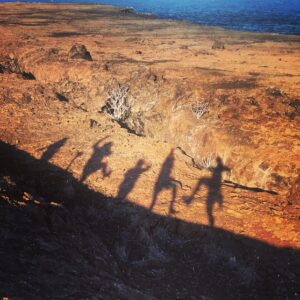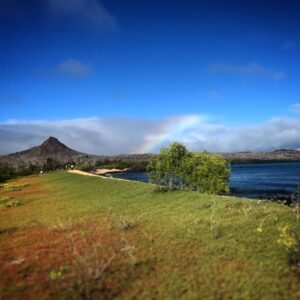
Spending time in nature is simultaneously calming and uplifting. Research suggests that simply walking in nature could lower your risk for depression, improve symptoms of anxiety, and improve cognitive functioning. Moreover, practicing mindful embodiment in nature with yoga or walking meditation can further align mind and body with the rhythms of our natural world.
This post offers photographs and reflections inspired by my recent trip to Peru and Ecuador. These images are from hiking the Inca Trail to Machu Picchu, trekking in old growth Amazon rainforest, and exploring the Galapagos islands. These travels evoked a deep respect for these extraordinary places and enhanced my appreciation for those who work to protect our precious planet.

“Embodiment in nature is a simple yet profound way to reset body and mind. We can experience the flowers, clouds, wildlife, and the subtle filtered quality of light as it passes through the branches of the trees. To retreat into nature inspires reflective awareness. Such mindful presence can so easily become lost in our intensely fast-paced and stressful world. Consequently, the quiet mind we cultivate in nature is so very necessary. Once discovered, we can offer the gift of spacious awareness to our relationships, work, and community.”
-Dr. Arielle Schwartz
Symbiosis is defined as any relationship that brings mutual benefit between two living creatures. In nature, interdependence is evident in the way that tiny plants grow on large trees and in the connection between insects and flowers.
We humans forget the importance of interdependence sometimes.
In truth, we are not meant to go about life alone. We all need to be seen, held, understood, respected, needed, and loved (whether we want to admit it or not). And, when we admit our own needs we give permission for others to do the same.
Embodiment in nature is all about feeling our own symbiotic relationship to our world. We are interconnected with the air we breathe, the water we drink, and the land we walk upon. Our earth depends upon our ability to protect her.
We awaken awareness of our relationship to the natural world by embodying what we witness in nature. The practice of yoga asana invites us to awaken our relationship to the natural world with postures such as mountain, eagle, cobra, camel, or fish. It can also be quite a joy to play with the shapes that you observe. For example, explore matching your environment by playfully mirroring a crooked tree, a bird taking flight, or an iguana slithering on the sand.
It is easy to take ourselves too seriously. But, spending time observing the natural world, I was struck by the remarkably playful behavior seen in animals. In the Galapagos, the sea lions toss rocks into the waves and catch them again like a dog playing catch. Blue footed boobies show off their pretty feet to invite a mate. The adolescent birds play with sticks tossing them in the air and catching them. Some of this play seems to serve a purpose…the stick tossing helps the bird prepare to build a nest later in life. Sometimes, animals simply play…and researchers have no idea why.
I believe we need play to survive. We need to allow time to play for no other purpose other than to have fun, to feel joy, to experience pleasure. And, there are so many benefits of play—it helps us bond with others, process our life experiences, tap into our creative resources, and reduce stress.
Embodiment in nature is, at heart, a playful exchange with the natural world. Engage in a somatic exploration of sensation, movement and stillness…but, don’t take yourself too seriously! Bark like a sea lion, scratch your head like a monkey, or pounce like a jaguar. Let yourself have fun.
It is so common to become mired in the details of life. Our body can begin to mirror this approach to life with our head lowered casting a downward gaze. Sitting for hours and staring at screen is part of the problem. The resulting collapsed body posture can fuel feelings of depression, anxiety, helplessness, and overwhelm.
Stepping into the nature provides ample metaphors for the terrain of our inner wilderness. Trekking the Inca Trail to Machu Picchu involved climbing 26 miles up and over mountain passes. Standing above 13,000 feet, I felt as though I was on top of the world. A condor flew overhead—pure magic! Entering ancient sacred sites evoked a sense of awe and reminded me that I am a very small part of history. It is hard to feel heavy hearted in the beauty of the natural world.
Going outdoors might be a natural anti-depressant. But, don’t just trust the research. Try it for yourself and engage in your own self-study. Notice how you feel before and after.
Are you inspired to take your embodiment practice outside? If so, I invite you to bring this inquiry along with you the next time you walk on a trail or spend time in your garden.
Take the time to become present by awakening your senses. Set an intention for your time outdoors. Allow yourself to observe the shapes of the natural world and playfully mirror these with your body, intuitively creating your own shapes. Savor the sensory details of the light, the sounds, the smells. Notice the way the clouds move or pause with a moment of gratitude for your strong legs that carry your body through the world. Embodiment in nature has the potential to bring us home to the very heart of who we are. As you complete your outdoor practice, take a moment to breathe into your body and mind. Notice what you bring away with you…and perhaps, with a moment of gratitude, ask yourself what can you give back to our earth in return?
Dr. Arielle Schwartz is a licensed clinical psychologist, wife, and mother in Boulder, CO. She offers trainings for therapists, maintains a private practice, and has passions for the outdoors, yoga, and writing. Dr. Schwartz is the author of The Complex PTSD Workbook: A Mind-Body Approach to Regaining Emotional Control and Becoming Whole (Althea press, 2016) and co-author of EMDR Therapy and Somatic Psychology: Interventions to Enhance Embodiment in Trauma Treatment (Norton, 2018). She is the developer of Resilience-Informed Therapy which applies research on trauma recovery to form a strength-based, trauma treatment model that includes Eye Movement Desensitization and Reprocessing (EMDR), somatic (body-centered) psychology and time-tested relational psychotherapy. Like Dr. Arielle Schwartz on Facebook, follow her on Linkedin and sign up for email updates to stay up to date with all her posts.

Arielle Schwartz, PhD, is a psychologist, internationally sought-out teacher, yoga instructor, and leading voice in the healing of PTSD and complex trauma. She is the author of five books, including The Complex PTSD Workbook, EMDR Therapy and Somatic Psychology, and The Post Traumatic Growth Guidebook.
Dr. Schwartz is an accomplished teacher who guides therapists in the application of EMDR, somatic psychology, parts work therapy, and mindfulness-based interventions for the treatment of trauma and complex PTSD. She guides you through a personal journey of healing in her Sounds True audio program, Trauma Recovery.
She has a depth of understanding, passion, kindness, compassion, joy, and a succinct way of speaking about very complex topics. She is the founder of the Center for Resilience Informed Therapy in Boulder, Colorado where she maintains a private practice providing psychotherapy, supervision, and consultation. Dr. Schwartz believes that that the journey of trauma recovery is an awakening of the spiritual heart.